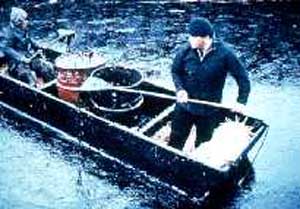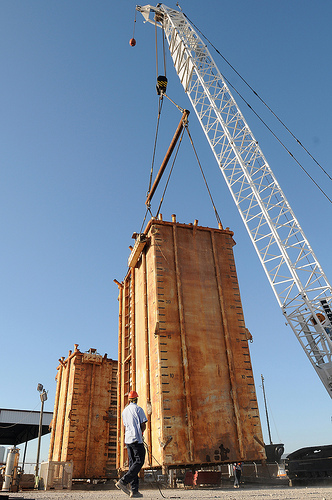As one of several service providers on the rig, Halliburton can confirm the following:
— Halliburton performed a variety of services on the rig, including cementing, and had four employees stationed on the rig at the time of the accident. Halliburton’s employees returned to shore safely, due, in part, to the brave rescue efforts by the U.S. Coast Guard and other organizations.
— Halliburton had completed the cementing of the final production casing string in accordance with the well design approximately 20 hours prior to the incident. The cement slurry design was consistent with that utilized in other similar applications.
— In accordance with accepted industry practice approved by our customers, tests demonstrating the integrity of the production casing string were completed.
— At the time of the incident, well operations had not yet reached the point requiring the placement of the final cement plug which would enable the planned temporary abandonment of the well, consistent with normal oilfield practice.
— We are assisting with planning and engineering support for a wide range of options designed to secure the well, including a potential relief well.
Halliburton continues to assist in efforts to identify the factors that may have lead up to the disaster, but it is premature and irresponsible to speculate on any specific causal issues.
Archive for April, 2010
Interesting Release from Halliburton
Posted in accidents, well control incidents, tagged accidents, blowouts, Deepwater Horizon, Gulf of Mexico, macondo, offshore oil, oil spill, safety, well control on April 30, 2010| Leave a Comment »
Morning Musing
Posted in accidents, well control incidents, tagged accidents, blowouts, drilling, Gulf of Mexico, macondo, offshore oil, oil spill, safety, well control on April 30, 2010| 4 Comments »
- Yesterday’s report that the Horizon crew tried to activate BOPE before evacuating is very significant. We have now learned that the crew, the fail-safe closure mechanisms triggered by the power-loss and riser disconnect, and the ROV backup could not close the rams. Therefore, the absence of an acoustic backup system does not appear to be significant in this incident. An acoustic backup or any other type of backup would just be signaling the BOP to close, the same way the crew and automatic systems did, and the result would have presumably been the same.
- A smart guy in Houston (doesn’t want his name used) raised an interesting thought last night. If they had time between the first flow and the start of the fire, would they have been better off initiating a drive-off routine that disconnected the riser from the well and moved the rig away from the location? (Keep in mind that this was a dynamically positioned rig.) The fire would have been prevented or minimized, lives might have been saved, and the rig would not have sunk. Why not establish an escape option that takes advantage of a DP rig’s mobility?
- The same contact also suggested that continuous pumping of fire-water into internal compartments may have caused the rig to sink.
- Escape procedures and lifeboat issues have not received much attention to date, but are sure to be an important aspect of the investigation.
- MMS postponed the National SAFE Awards scheduled for Monday. This was the correct decision under the circumstances.
Macondo Update
Posted in accidents, well control incidents on April 29, 2010| Leave a Comment »
I missed today’s news conference, but Upstream has excellent coverage including information that the crew did try to activate BOPE before evacuating.
Posted in Uncategorized on April 29, 2010| Leave a Comment »
“The responsibility for safety on the drilling rig is with Transocean,” Hayward said. “It is their rig, their equipment, their people, their systems, their safety processes.” Tony Hayward, BP CEO, in a CNN Interview
Mr. Hayward has been under a lot of stress, and probably hasn’t had much sleep, so we’ll assume he didn’t really intend to make this comment. BP and Transocean are both part of the “Unified Command.” We need for them to work as partners, at least until the well is secured.
Macondo “Street-Talk”
Posted in Uncategorized on April 29, 2010| Leave a Comment »
Needless to say, there is tremendous worldwide interest in this tragic incident, and everyone is asking what happened. While details will be determined during the official investigations, the Unified Command should be able to provide basic information on the status of operations at the time of the blowout. Absent that, we are dependent upon unconfirmed reports that are circulating among industry contacts in Houston. In that regard, the prevailing view is that production casing (which extends to the bottom of the well) had been cemented, and that a cement plug (flow barrier) was being set inside that production casing as part of the temporary abandonment (suspension) program. Beyond that, information is sketchy and inconsistent.
Macondo Overnight Update – 29 April
Posted in accidents, well control incidents, tagged accidents, blowouts, Deepwater Horizon, drilling, Gulf of Mexico, in situ burning, macondo, offshore, offshore oil, ohmsett, oil spill, safety, well control on April 29, 2010| Leave a Comment »
- NOAA estimates that flow rate could be up to 5000 BOPD. Comment: The technical basis for this and other flow estimates should be provided.
- First in situ burn conducted successfully. Comment: No surprise. In situ burning is neither new nor unproven. This is the best means of removing large volumes of oil from the water quickly and completely. Kudos to the in situ burning pioneers – Ed Tennyson, Dave Evans, Al Allen, and Merv Fingas. Kudos to the folks at Ohmsett where slick burning and fire booms were tested extensively in a tank. Kudos to Canada and Norway for having the foresight to allow this capability to be tested in experimental offshore spills. Unfortunately, these small, controlled research spills are virtually impossible to conduct in US waters.
- Department of Defense being contacted for suggestions. Comment: Appropriate step, but don’t expect any ideas that have not been previously considered.
- BOP actuation and cementing operations (also a major point of discussion during the Montara hearings in Australia) are receiving press attention. Comment: These issues will be a major focus of the investigation. The findings will be discussed and applied internationally.
- A third oil release point has been identified near the base of the riser.
Macondo – Day 9 Update
Posted in accidents, well control incidents, tagged accidents, blowouts, Deepwater Horizon, drilling, Gulf of Mexico, macondo, offshore oil, oil spill, safety, well control on April 28, 2010| Leave a Comment »
No major new developments were mentioned at today’s Unified Command Briefing (1500 CDT). Summary:
- Still unable to secure the source by actuating BOPE with the ROV. New intervention options are being designed.
- The in situ burn program was scheduled to begin today, but a report is not yet available.
- Subsurface containment and collection system will be ready in 2-4 weeks
- Development Driller III will spud relief well by Friday
- 100,000 feet of boom deployed for coastal protection purposes
- No apparent change in well flow rate.
Cape Wind Project Approved
Posted in Offshore Wind, Wind Energy, tagged Cape Wind, Offshore Wind, Wind Energy on April 28, 2010| Leave a Comment »
Macondo: Unprecedented Response
Posted in accidents, well control incidents, tagged accidents, blowouts, Deepwater Horizon, drilling, Gulf of Mexico, macondo, offshore oil, oil spill, safety, well control on April 28, 2010| 1 Comment »
During the 1969 Santa Barbara blowout, dedicated volunteers did their best with straw, wooden booms, detergents, rakes, and their own ingenuity. Fast forward to the Macondo response: stockpiles of tested dispersants and plans for applying them most effectively, fire boom and research data to support burning oil in situ, an armada of skimming vessels, boom deployed by trained personnel, a scientific support team, and a pioneering subsea collection system. Without a doubt, every effort is being made to minimize the damage associated with this spill.
There are 2 suggested improvements that I have alluded to previously. These relate to information that is being provided to the public.
- The data on the volume of oil/water mixture that is being collected would be more useful if we knew the oil fraction. Without this information, the effectiveness of the response and the potential for environmental impacts are difficult to assess. Based on the collection figures provided to date, weather conditions, the seafloor release point for the oil, and the estimated flow rate, I would assume that the mixture is mostly water. If no chemical analyses are available, perhaps an estimate (range) of the oil percentage could be provided.
- Very little specific information is being provided on the important subsea intervention operations. A weekly summary of these operations would be helpful. For each attempt, the procedure and outcome could be provided.
Posted in accidents, well control incidents, tagged accidents, blowouts, Deepwater Horizon, drilling, Gulf of Mexico, macondo, offshore oil, oil spill, safety, well control on April 28, 2010| Leave a Comment »




